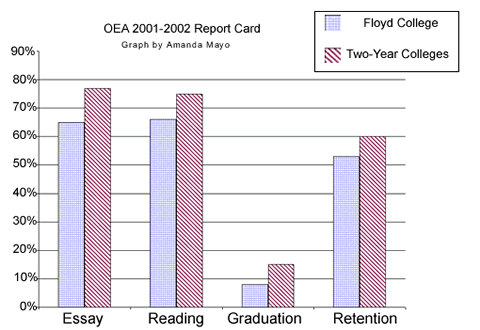
OEA report card requires more explanation
By Daniel Bell
Editor
The Office of Education Accountability (OEA) recently released
to the general public its first annual report on the University System
of Georgia (USG).
The report card, which can be viewed at www..ga-oea/report_card.org,
may reflect poorly on Georgia Highlands College to the uninformed viewer.
Dr. Randy Pierce, President of Georgia Highlands College, said, “I am not satisfied
with the results. We need to work to improve everything. But there are
special circumstances that need to be considered.”
The OEA’s 2001-2002 report card focuses on four indicators: retention
rates of first-time, full-time, degree-seeking students; graduation rates;
pass rates on both parts of the Regents’ Test; and pass rates on
licensure/certification exams.
A student is considered a first-time, full-time freshman if he or she
is in his or her first semester of college and taking at least 12 hours.
According to Pierce, the report card only takes into account a small portion
of the total enrollment at Georgia Highlands College.
“Less that half of our students are full-time,” said Pierce.
“We have a lot of non-traditional students who work and have families
and may be only taking one or two classes.”
Retention rates for an institution of higher education are an indicator
of the institution’s success in keeping students enrolled from their
first year to their second year. The rates are based on first-time, full-time
freshmen that continue enrollment the following fall semester, one year
after they began.
The report shows not only the number of students who remained at FC for
their second year but also the number of students who enrolled at another
USG institution after their first year at FC.
Georgia Highlands College shows a retention rate of 53 percent. That means that 53
percent of the first-time, full-time college students who were freshmen
in fall 2000 were still at FC fall 2001. When the number of former Floyd
College students who enrolled at another USG institution Fall 2001 is
considered, the total becomes 56 percent.
These totals are slightly lower than the average for all two-year colleges
in Georgia. The average institution-specific retention rate for the 13
two-year colleges is 60 percent. The system-wide average (meaning students
who are still enrolled somewhere) is 67 percent.
The Office of Educational Accountability reports graduation rates of all
USG institutions. The normal duration for associate degrees is two years,
but the USG uses a “time-and-a-half” rate that reports the percentage
of students completing their associate or transferring to four-year institutions
within a three-year period.
Georgia Highlands College’s institution-specific graduation rate refers to students
who earned a degree from FC within three years. That total is 8 percent.
Another 19 percent transferred to four-year institutions in the University
System of Georgia.
These numbers, when compared to the two-year college average, are somewhat
low. The average institution-specific graduation rate is 15 percent and
the system-wide total (students who transferred) is 28 percent.
“Most students who come to Georgia Highlands College never intend on graduating
from here. They come to get their start and then transfer,” explained
Pierce.
The Regents’ Test is used to ensure that students receiving degrees
from USG institutions possess certain minimum skills in reading and writing.
Non-career students are required to take the two-part test the semester
after they have completed 30 semester hours and before they reach 45 hours.
Students who do earn 45 semester hours and have not taken the Regents’
Test, or who have failed one or both parts, must enroll in remedial courses
until they pass both parts.
The OEA report card showed that Georgia Highlands College had a passing rate of 65
percent on the essay portion and 66 percent on the reading portion of
the exam during 2000-2001. Both totals are lower than the two-year college
average. The overall totals for all USG two-year colleges for the essay
and reading portions are 77 percent and 75 percent, respectively.
Georgia Highlands College’s numbers did increase with the administration of the
Regents’ Test last fall. Of the first-time examinees, 77.99 percent
passed the essay portion and 77.99 percent passed the reading portion.
These numbers are not reflected in the OEA report.
At press time the licensure/certification exams totals were not available.
Licensure/certification exams only apply to FC with the nursing and dental
hygiene programs. When students complete their degrees in these areas,
they then have to take the exams to become licensed or certified before
they can practice.
According to Pierce this is one area in which Georgia Highlands College excels.
“Our dental hygiene program had a 100 percent pass rate last year
and the nursing program had a 94 percent pass rate,” he said.
Former governor Roy Barnes established the Office of Education Accountability
in July 2000 with the goal of improving student achievement and school
completion.
OEA’s major purpose is the establishment of performance-based accountability
standards for all of Georgia’s education system, from pre-kindergarten
through postsecondary grades.
The report card on the University System of Georgia is a part of this
goal. USG’s Board of Regents governs 34 institutions: including four
research universities, two regional universities, 13 state universities,
2 state colleges and 13 two-year colleges.
Data are reported as provided to OEA by USG and currently reflects the
2000-2001 academic year.
| Front Page | News | Editorials | Opinions | Features | Entertainment |
| Sports
| Archives | Our
Staff | Application | History
| F.A.Q.'s |
![]()
Copyrighted © 1999-2001 Six Mile Post
All Rights Reserved

